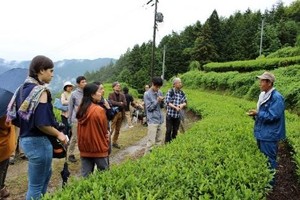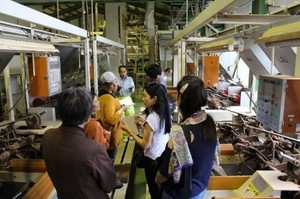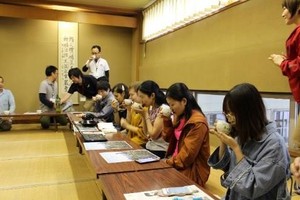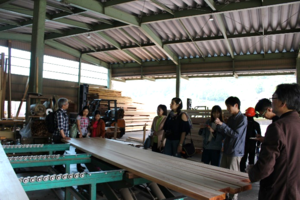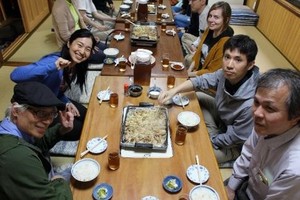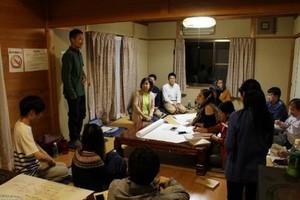Home![]() Clinical Environmental Studies Program
Clinical Environmental Studies Program![]() On-site Research Training(ORT)/SDGs basic seminar
On-site Research Training(ORT)/SDGs basic seminar![]() 【1/3】Report on On-site Research Training (ORT) at Higashi-shirakawa Village and Shirakawa Town, Gifu
【1/3】Report on On-site Research Training (ORT) at Higashi-shirakawa Village and Shirakawa Town, Gifu
Clinical Environmental Studies Program
2018-06-14 【1/3】Report on On-site Research Training (ORT) at Higashi-shirakawa Village and Shirakawa Town, Gifu
2018 Integrated Environmental Studies course on-site research training (ORT) class was conducted in Higashi-Shirakawa village and Shirakawa Town, Gifu Prefecture.
(1) Purpose of practical training
In order for students to identify sustainability issues at a locality and to attempt diagnosis and prescription development of the issues, students go to Shirakawa town and Higashi Shirakawa village of Gifu prefecture and conduct field survey on local industries, natural environment, local administration and development. The students (doctor course) shall develop their own research plans based on the learning from this field study by all members.
(2) Implementation report
Time: 2018, May 31 (Thursday) - June 2 (Saturday)
Location: Higashi-Shirakawa village and Shirakawa town in Kamo-gun, Gifu Prefecture
Participants: 4 PhD students, 2 master students, 1 research student, 12 professors, 1 office assistant staff, 1 translator (visiting professor)
Local collaborators: Higashi-Shirakawa village office, Shirakawa town office, etc. Other person in charge
Content of implementation: interviews and workshops from administrative and local organizations, tour of activity sites and natural environment
May 31st -- Higashi - Shirakawa Village
A bus travel of one hour brought us from Nagoya to the mountains in Gifu prefecture. We crossed different rivers, like the Kiso River, which belong to the Ise Watershed Area. During the bus trip, the professors let us reflect about the connection between mountains, the rivers and the Ise Bay and its wetlands more downstream.
1.Tower of Tenshin-Shiragiku
17 August 1968 was a tragic day: after a cold front hit the mountains, heavy rain caused floods and landslides, and 104 people in two buses died. The field trip started with a stop at the memorial where we got reminded to the natural disasters and the vulnerability of Japanese people. In Japan, forest is synonymous for steep hills and mountains. This implies a risk for landslides and other mountain-related disasters.
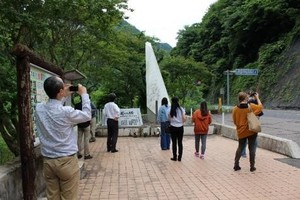
2.Introduction on Higashi Shirakawa
Mr. Makoto Yasue, the director of the General Affairs Division, introduced us about this village. He told us about the history and the characteristics. Something remarkable is the absence of buddhist temples. Another topic was the education. In the primary school, the present 85 students learn often through experience, participate in outside activities such as picking tree, growing rice, forestry, climbing mountains, and also get responsibility in e.g. cleaning. The specialties of the village are the Shirakawa tea, products of the Hinoki (including "Forestyle"), tomatoes, and the unique events. He also mentioned "Tsuchinoko", an indigenous animal that lives in this village, and is celebrated annually on May 3rd with the means of a big search. Afterwards, there was a Q&A, and questions were raised about the community, the local economy, tourism and also about the emerging "Akiya" (empty house) challenge.
3.Lunch in Forest Restaurant Ajisai
We ate the organic pork "Anshin-ton" of the farmer that we would visit on the third day. The dish also contained mountain pepper, miso soup, rice and other delicious side dishes.
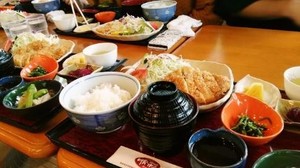
4.Green Tea Plantation
Mr. Miyoshi Yasue, a green tea farmer, with a strong young spirit, took us to a height of 600 meters and taught us about his life project. 50 years before he made this field ready for green tea plantation, and produced very high quality tea leafs. The colder temperature in the mountains made him invest in wind fans which circulate the air in order to avoid frost falling on the leafs. His biggest concern is the decreasing price of tea, partly caused by the decreased demand for tea by Japanese people, as part of lifestyle change. The low price does not also make the industry attractive for young people.
5.Short Introduction about Akiya Issue
During our bus ride to the next stop, Professor Hisashi Komatsu gave a short introduction about the raising concerns about "empty houses" in Japan. 13.5 % of the houses are empty, and in this area it is even 20%. The factors are technical, social, political and economic, and it is a complicated matter.
6.Green Tea Production
Mr. Yukimori Yasue, the deputy head of the Union of Green Tea Production in Higashi-Shirakawa, treated us on a tour in the factory and then on some cups of cold tea (Sencha). The plant only works two months/year, after the two harvests, and is for the rest not operational. In the first picture, Mr. Yukimori Yasue (in light-blue shirt) is guiding us in the tea plant.
7.Forestry Processing Plant (Yamakyo CO., Ltd.)
Mr. Kiyoshi Yasue, the Vice President, showed us the machines and the processing of Tono Sugi (Japanese Cedar) and Tono Hinoki (Japanese Cypress). The smell of Hinoki is really heavenly. He explained that you need different machines depending on the quality of the wood. A challenge for him is to find highly motivated young people to replace the soon-to-be-retired employees.
8.Dinner in "Shirakusa"
We ate local food named "Kei-chan", grilled chicken and vegetable with miso taste.
9. First Workshop with 3 young newcomers
In the evening we hosted a workshop with young people who recently moved (from urban areas) to this village. The first person is Mr. Toshihiko Takahashi, who belongs to Chiiki Okoshi Kyoroku Tai ("Volunteers for cooperation in community revitalization"). He is promoting local products with his IT skills. As second, Mr. Hiroki Onishi shared his life story; from building ice hotels in Hokkaido to farming rice in this village. Also, Mr. Ginjro Higuchi, who is managing the Akiya bank, joined the workshop and shared more insights about the akiya issues. After a short interview, three groups were formed, and we talked separately with one of the three young people about their life, their mission and vision in this village. The talks were characterized by positive energy and admiration for the beauty of the place. In the picture, Mr. Hiroki Onishi is giving his thought after the student's presentations.

